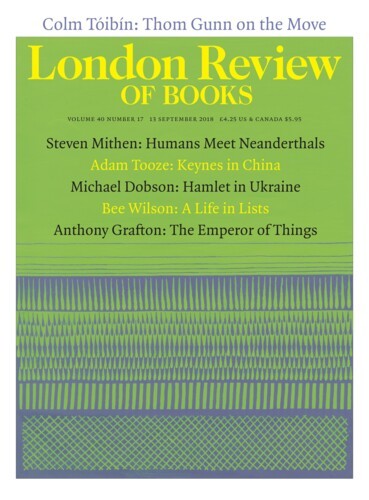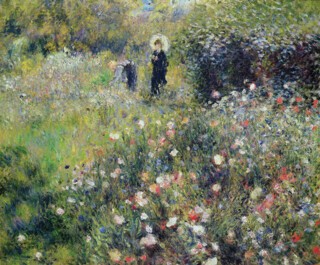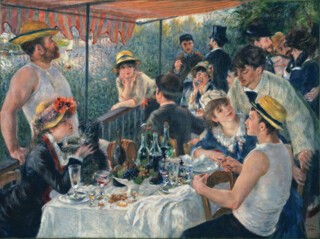The retort was cutting. Albert C. Barnes, the Philadelphia art collector who by the time of his death in 1951 owned 181 paintings by Auguste Renoir, was trying to one-up Duncan Phillips, who had recently spent the then considerable sum of $125,000 on Luncheon of the Boating Party – widely considered one of Renoir’s greatest works (and still the highlight of the Phillips Collection in Washington). ‘That’s the only Renoir you have?’ Barnes asked. ‘It’s the only one I need,’ Phillips replied.
It’s a story about two different styles of collecting, but it also shows the way the view of Renoir changed among collectors of modern art. The two masters of modern painting, according to Barnes, were Cézanne and Renoir, and ‘to avow an unqualified preference for either is to confess to an essential shortcoming in one’s own personality.’ One can, however, detect a preference on Barnes’s part: ‘Cézanne’s interests were very much narrower in range than Renoir’s, they never displayed any such capacity for growth, and they never had at their service a comparable command of the medium of paint.’ Leo Stein, born in 1872, the same year as Barnes, had an equally exalted view of Renoir, praising ‘the serene graciousness of his pure and noble joy’. Phillips, born in 1886, saw things differently. To him, Renoir was still important, but you had to be choosy about his work.
Renoir has remained a crowd-pleaser, but he’s no longer considered the equal of Cézanne – who himself professed, late in life, to despise ‘all contemporary painters, except Monet and Renoir’. By the 1950s, it had become a commonplace that Cézanne and Monet were the two prophets of modern painting. Renoir, it was said, may have been a radical early on, but after the mid-1880s his imagery grew sentimental, his style soft and blowsy. We can no longer imagine how it occurred to the pianist Misia Sert to explain Stravinsky to Renoir by saying, ‘He is in music what you are in painting.’ Renoir is seen as having lost his nerve. According to Linda Nochlin, ‘after the bold attempt of Impressionism to eradicate the past and create an art modern in both its formal strategies and its subject matter’, Renoir and others, ‘dissatisfied with the openness, instability and vivid contemporaneity characteristic of high Impressionism’, ‘attempted to restore a sense of permanence, timelessness and high-minded harmony to their art’. He turned his back on ‘the present in its complexity, dynamism and destabilisation of traditional relationships; its confrontation of gender and class issues; its engagement with urbanism and modernity’, and produced instead reactionary kitsch.
If Renoir’s sin was his self-indulgence, it wasn’t a lapse: he pursued it as a programme. When, as a student, his teacher Charles Gleyre inquired whether ‘it’s to amuse yourself that you are dabbling in paint?’, Renoir was forthright in his response: ‘If it didn’t amuse me, I beg you to believe I wouldn’t do it.’ Coming from a poor family, there had been no straight road to the fine arts. Born in 1841, the eldest son of a tailor, his family moved from Limoges to Paris when he was three and he grew up a quintessential urbanite. As an adult, it’s said, ‘he spoke like a working-class labourer with a rasping guttural Parisian accent.’
He was apprenticed in a porcelain painting workshop, where he graduated from doing simple border patterns to portraits of Marie Antoinette and imitations of the Old Masters. He fell in love with Watteau and Boucher. His colleagues, making fun of him, dubbed him ‘Monsieur Rubens’. When the workshop closed down, Renoir worked at other forms of decorative painting: screens, window blinds and so on. He also began studying fine art, and copied works in the Louvre – by Rubens, among others. After taking preparatory lessons with Gleyre, he enrolled at the Ecole des Beaux Arts, where his teachers ‘were unanimous in finding my paintings execrable’. A version of Rubens’s Hélène de Fourment et ses enfants from 1863 already has a characteristic lightness and buoyancy.
Renoir became part of the group that gathered around Manet and which included several other rebellious former students of Gleyre’s, among them Monet, Bazille and Sisley. Poorly received at the annual salons – when their works weren’t rejected outright – the young painters eventually organised independent exhibitions, the first of which took place in 1874 in the photographer Nadar’s studio. Manet, who still wanted the recognition of the salons, refused to take part, but his protégés joined in. A journalist seized on the title of one of Monet’s paintings – Impression: Sunrise (1872) – and the movement was inadvertently christened. In 1877, to promote the group’s third exhibition and explain their ideas to the public, they took up the name themselves and founded a journal, L’Impressionniste.
All of this – from Renoir’s birth in 1841 to 1877, nearly half his life – takes up just the first chapter of Barbara Ehrlich White’s Renoir: An Intimate Biography. It’s an odd decision on her part. It isn’t that there’s a lack of sources: Renoir’s childhood is recorded in his reminiscences to his son, and from the time he began meeting with the other Impressionists in Gleyre’s studio the documentation is copious. The reason, as White explains in her introduction, is that she has based her research on her own archive of Renoir’s correspondence: she has copies of some three thousand letters, many of them unpublished, which she has been collecting since 1961, when she began her dissertation at Columbia. Presumably most of these letters were written in the latter part of Renoir’s life, when success meant lots of business to attend to and more time away from family and friends. The weekly meetings with Manet and the others at the Café Guerbois or the Café de la Nouvelle-Athènes presumably obviated the need to thrash out artistic ideas in writing during the crucial early years of Impressionism.
The letters are, of course, an invaluable source, but they pose problems of their own. Renoir could be, as White says, ‘conflict-avoiding, double-talking, secretive, shrewd and even sneaky. To stay in the good graces of those on whom he depended, he ingratiated himself with friends of different opinions whose favour he needed.’ Unsurprisingly, ‘this led him sometimes to express diverse thoughts on the same topic to different acquaintances.’ She is particularly keen to show that, despite certain comments about Jews and women in his letters, he was not an antisemite, or sexist – at least by the standards of his day. This is letting him off too easily. The question of antisemitism has little to do with the content of Renoir’s paintings, but the depiction of women is central, and should have been probed more deeply – not by reading the letters, but through a closer look at the paintings themselves.
Another problem is that Renoir seems not to have been a terribly interesting letter-writer. He clearly saw correspondence as a practical task, and wrote little about his work and ideas. White’s biography has a lot to say about Renoir’s family life, but the paintings are treated lightly. White defines her task as answering the question ‘What was Renoir’s character and personality?’ but doesn’t seem to consider that he may have invested his character most deeply in his paintings. Renoir himself put it bluntly to a journalist who was writing about a collection that included many of his paintings: ‘He can say as much as he wants about my canvases, but I hate the idea of the public knowing how I eat my cutlets and whether I was born of poor but honest parents. Painters are very boring with their pitiful stories, and people don’t give a damn about them.’
Renoir’s daily life did of course feed into his paintings. White has an interesting notion about the change that came over his art in the mid-1880s, the period Nochlin characterises as a rappelle à l’ordre closing the great adventure of the Impressionists’ plunge into contemporaneity: she attributes it to the birth of his first acknowledged child, Pierre. ‘After Pierre was born,’ she writes, ‘he never depicted an adult man wooing an adult woman in a modern setting’ – a typical subject of his earlier paintings. Indeed, from this point, ‘adult men almost completely disappear … They are replaced, at Pierre’s birth, by male children. He no longer painted large groups of figures in the city and suburbs’ – as in Luncheon of the Boating Party – but rather ‘individuals and small groups of women and children in the country’.
This brings us to the edge of some interesting psychosexual territory, but White goes no further. She claims that many of Renoir’s artistic choices represent a symbolic compensation for problems he faced in real life, but it isn’t clear what lack is being offset here. Later, she observes that the female figures in his late work ‘grew heavier and more active while he himself became thinner and less mobile’, as though they were sucking the vitality out of him. But Renoir was desperately struggling to keep painting as his rheumatoid arthritis worsened, eventually deforming his fingers and partially paralysing his face.
‘Things are all botched up for painting,’ he wrote to one of his dealers, ‘I won’t be able to do anything any more.’ Yet he continued to paint every day. Cigarettes were lit for him and placed in his hand; then removed and replaced with a brush when he was ready to continue painting. White discounts reports that the brush was tied to his hand, though Jean Renoir recalls his father’s use of a contraption that allowed him to work on very large paintings:
It was a sort of ‘caterpillar’ arrangement, made of slats nailed onto a long strip of heavy canvas, which was rolled around two horizontal cylinders, a little over a yard wide, one near the ground, the other about seven feet above. He had his canvas fastened on to the slats with drawing-pins. By turning the lower cylinder with a crank, the strip of canvas could be unrolled either way, and so bring any part of the motif that Renoir wanted to work on to the level of his eye and arm.
Right until the end he dreamed of painting vast wall-filling canvases like the Venetians of the Renaissance.
From the 1890s, when he began to suffer from arthritis, his painting became increasingly broad and loose – ‘sketchy but superb’, as the dealer Paul Durand-Ruel called it. The generalisation of the drawing gave even more scope for his rich, flowing colours to mingle and heighten one another. Barnes was right in saying that ‘colour takes command, as it were, of the total design by becoming the agent of co-ordination of all the plastic means and compositional factors.’
White begins her book by dismissing Jean Renoir’s memoir of his father as ‘historical fiction’. Yet she doesn’t refute a word of Renoir, My Father. She cites it sparingly, but without further criticism, sometimes repeating a comment or anecdote more than once, for instance Jean’s claim that his father ‘seldom if ever set foot in a church’. I lost count of how many times she repeats Pissarro’s exasperated question about Renoir: ‘Who can fathom that most inconsistent of men?’ White would have done better to rely more on Jean’s recollections of his father’s recollections – published forty years after the conversations on which they were based – to flesh out the dry bones of Renoir’s correspondence. The three pages Jean devotes to describing the arrangement of his father’s palette explain as much about Renoir’s art as whole chapters of White’s biography, and his catalogues of his father’s likes and dislikes tell us far more about his ‘character and personality’. One of them lists the things he considered ‘rich’:
Parian marble, ‘which is pink and never chalky’; ivory black; Burgundian or Romanesque roof tiles covered with moss; the skin of a healthy woman or child; brown bread; meat grilled over wood or charcoal fires; fresh sardines; flagstone pavements or streets paved in sandstone of a slightly bluish colour; ashes left in a fireplace; workingmen’s blue jeans after they have been washed and mended a number of times.
Send Letters To:
The Editor
London Review of Books,
28 Little Russell Street
London, WC1A 2HN
letters@lrb.co.uk
Please include name, address, and a telephone number.



